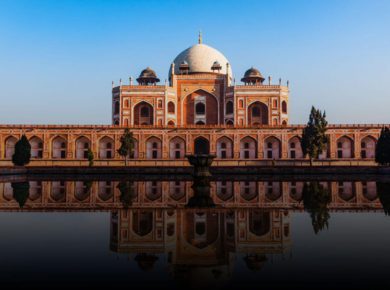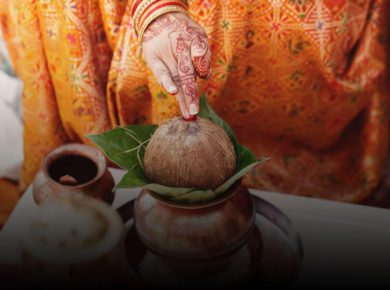Post Mauryan Art
India after Mauryas was a not a very remarkable period for political solidarity but it saw development of Indian culture to a great extent. After the successors of Ashoka failed to keep the empire intact, various small kingdoms emerged in the face of Indian subcontinent. The Mauryan Dynasty was soon replaced by the Sunga dynasty.
Post Mauryan India
- Northern Central Ruled by [arr] Shungas, Kanvas, and Guptas
- Western Southern Ruled by [arr] Satavahanas, Ikshavakus, Abhiras, Vakataks
- Marked the Re-emergence of main Bramhanical sects such as the Vaishnavas and the Shaivas
Caves
Mainly three architectural types were executed (Western India – 200 BCE)
| Apsidal Vault | Roof Chaitya halls | found at Ajanta, Pithalkhora, Bhaja | |
| Apsidal Vault | Roof pillar less hall | found at Thana – Nadsur | |
| Flat quadrangular hall with a circular chamber at back | found at Kondivite | ||
|
In all the chaitya caves a stupa at the back is common Viharas consists of a veranda, a hall and cells around the walls of the halls |
|||
| Chaitya [arr] Prayer hall for monks | Viharas [arr] Residence / Resting place of monks | ||
Stupas
- A lower pradakshinapatha or circumbulatory path was added along with the upper one at Stupa – 1 (Sanchi)
- All the four gateways were now carved with beautiful sculptures.
- Depiction of picture got naturalistic with no stiffness in the body
- Figure compositions became high in relief – filling up the entire space
- Carving technique appeared more advanced
- Symbols continued to be used representing the Buddha
Sculptures (100 CE)
- The apex of the sculpture making is said to be found in this period
- Imporatant centers – Gandhara (now in Pakistan), Mathura in India and Vengi in Andhra Pradesh
- Buddha in the symbolic form got a human form in Mathura and Gandhara.



Gandhar School of Art (50 BC – 500 AD)
- North-western part of the Indian sub-continent – Buddhist School (Mahayana)
- Mainly Greco Roman style – Buddha image was inspired by Hellenistic realism, tempered by Persian, Scythian, and Parthian models
- Buddha images resembled the portrayal of God Apollo – Apollonian faces, hair in Greco-Roman style, draperies arranged in style of a Roman
- Carved Spiritual Buddha [arr] represents calmness, Bearded, Moustache, wearing ornaments, Wavy hair (Greek), large forehead (Greek) [arr] Bodhisattavas position
- Buddha seated in position of yogi, having large ears (Greek), Eyes half closed, Protuberance on his head (signifies that Buddha knows all)
- Owed its origin to Indo Greek rulers, but real patrons were shaka & kushanas esp. Kanishka
- Early School used bluish grey sandstone & later school used Mud and Stucco (lime plaster) however marble was not used.

Gandhara Art is shown making four types of hand gestures and this is a remarkable feature in this art. The gestures are as follows:
- Abhayamudra : Don’t fear
- Dhyanamudra : meditation
- Dharmachakramudra: a preaching mudra
- Bhumisparshamudra: Touching the earth




- Sculptors constructed Buddhist images with anatomical accuracy, spatial depth, and foreshortening.
- Depiction of Budhha in Sitting & Standing position with great attention to body details
- Seated Buddha is always shown cross-legged in the traditional Indian way. Buddha is seated on a lotus thron
- Attributes to tallest rock-cut statue of Lord Buddha – Bamiyan (Afghanistan) – 3-4 century AD.
Mathura School of Art (50 BC – 600 AD)
- Purely indigenous in nature, reaching its zenith under the Kushanas, mainly Kanishka
- Drew inspiration from ancient Indian art of Bharhut and Sanchi [arr] Initially inspired by Yaksha Images
- Not limited to only the images of Buddha but also the Jainas, Female deities & Hindu gods [arr] Secular
- Established tradition of transforming Buddhist symbols into human form
- Earliest sculptures of Buddha were made keeping the Yakshaprototype in mind.
- Both sitting and standing posture of Buddha in delighted state, not spiritual
- Buddha’s head and face Shaven, dress is tight; energetic body, face reflects grace
- 1st to depict smile on the face of Buddha but less expressive than Gandhar school
- The halo around the head of Buddha was profusely decorated which was not the case in Ghandhar school





- Buddha shown seated in Padmasana, Right hand in AbhayMudra (Indicate reassurance) raised above shoulder, Left hand on left thigh (reflect muscularity), Protuberance on head.
- Buddha is seated on lion thron.
- The Sarvatobhadrika image of 4 Jain Jinas standing back to back belongs to the Mathura school.
- Famous for headless statue of Kanishka
- Material used was red sandstone mainly with a little use of terracotta
- Reached its peak during the Gupta period
Amaravati School of Art (200 BC -200AD)
- Flourished on banks of Krishna river (Andhra Pradesh)
- Main patrons – Satavahanas & Ikshvakus
- White Marble (limestone) was used in this art
- Site of largest Buddhiststupa of South India.
- Themes were Buddha’s life and Jatakas tales [arr] Mainly Buddhist
- Curly hairs of Buddha [arr] A feature that is influenced by the Greeks.
- Sculptural composition is more complex and characterized by intense emotions, bodies are shown with three bents (i.e. tribhanga)
- In this school, statues of Kings, Princes, and Palaces got prominence.












1 comment
sir can you provide ias score Question papers with solutions